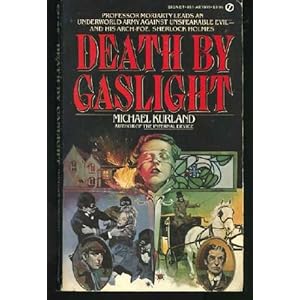Tuesday, October 4, 2011
TIME CAPSULES classic book reviews by Bill Lindblad
THE INVISIBLE MAN by H.G. Wells
This is a book which contains almost no horror, but which was presented at the time of its publication as a frightening story and which has served as a foundational work to the modern horror story.
The key traits of this 1897 novel are the titular invisibility and the steady degradation of the scientist's mental state. Both of these have become standard features in horror fiction, with the first being extended beyond men to a variety of invisible beings and the second becoming one of the default reasons for any scientific malfeasance (completing the trio with "avenging humiliation/rejection of theories" and "the search for knowledge has no morality".)
The story is remarkably thin, and can easily be broken into four segments: meeting the invisible man, the invisible man on the run, how he became invisible, and the invisible man attacks. It is a fairly tight narrative and it stands up remarkably well for its age. Where it fails is in the generation of suspense.
When Wells wrote the novel, he could rely on the very notion of an invisible person... who might be standing beside you, ready to stab or bludgeon... to generate much of the anxiety of the story. The intervening years have made the idea fairly commonplace, to the point where it is now a common trait for a hero as well as a villain (the Legion of Super-Heroes' Invisible Kid, the Gemini Man, etc...) We have also seen advances in technology such as infrared cameras or hypersensitive listening devices that have rendered invisibility steadily less useful.
His psychotic villain is also fairly benign. The invisible man begins his fall with theft and, until shortly before the end of the book, he never does more than threaten serious violence. He reserves any violence for those who have betrayed his trust. In fact, by today's standards, he shows no real loss of mental stability. That aspect was shown at the time of the novel's writing by his movement from frustrated gentility to violence, but in contemporary times there is no societal demand for people to maintain composure in the face of adversity.
It's still a very good book. And it is a key book in the development of both the modern horror and science fiction fields, which is what earns it another star on my review. If it fails to maintain the intellectual dread of another book Wells wrote around that time, The Island of Dr. Moreau, that is not much of a criticism.
Five stars out of five.
DEATH BY GASLIGHT by Michael Kurland
Moving from the 1890s English countryside into 1890s London, Michael Kurland provides an interesting addition to the hundreds of Sherlock Holmes stories which have followed from Sir Arthur Conan Doyle's original. In this book, Moriarty is the star, and a somewhat maligned star at that.
Kurland presents Moriarty is a somewhat amoral scientist whose brilliance and refutation of Victorian values have combined to paint him as a manipulative criminal lord in the mind of Holmes. While Moriarty does not feel compunction at breaking some laws, he is maneuvered into taking some of his most notorious actions and forming some of his less savory associations from the canon by the incessant pestering of Holmes.
This is not a simple cat and mouse detective novel, however. In the tradition of most 1890s London horror stories, it incorporates Jack the Ripper. In a surprising twist, however, far more time is given another brutal point of fame of that era. Mix in a series of slashed throats and the result is a surprisingly dark period mystery.
This 1982 offering from Signet is strongly recommended to any fans of Holmes or period pieces.
Four stars out of five.
(Sorry, but there is no image available for this book online)
THE DEADLY ELECTION by Mort Castle
If this Manor Books title from 1976 isn't Mort Castle's first book, it is one of his earliest. The writing isn't as smooth as his later works, and the scene transitions often seem forced. Those criticisms aside, however, this is an amazingly fun book, and I am convinced Mort enjoyed producing it.
Most of the traits of the 1970s adventure novels were expertly spoofed in this book. The plot focuses on the attempt of a madman to rise to the Presidency: he will incite massive and capricious social violence behind the scenes, then present himself as a law-and-order candidate behind a Guardian Angels-style group of protectors.
The violence is amazingly overwrought. Train bombings. Nerve gassing a youth camp. Street murders. Gunning down police stations. Why go to such extremes, you might ask? If you ask, you've never read a 1970s adventure novel. Castle revisits the "big villains gathered at a table" scene on display in multiple James Bond movies. He includes the requisite psychic character on the requisite small team of abnormally well trained agents chosen to end the diabolical plot.
Who is the person responsible for gathering the heroes together and providing them direction? A cross between Siegel & Schuster and Walt Disney, of course. Supermanland or a near approximation thereof would be the natural home of a good guy.
The author manages to ride the fine line between parody and self-parody without sacrificing story, as unbelievable as the story may be. It is an enjoyable page-turner with some significant horror elements, and while it is certainly a product of its time period that does not diminish its value, especially when compared against the books which inspired it.
Four stars out of five.
--Bill Lindblad


